Framework for Microdosing Odors in Virtual Reality for Psychophysiological Stress Training
Abstract
:1. Introduction
1.1. Main Aim of the Work
1.2. Olfactory Virtual Reality Technology
1.3. Odor Dosing with Piezoelectric Metal Micropumps
1.4. Use of Odors in VR Stress Training for Emergency Personnel
1.5. Triggering Psychophysiological Stress via Odors in VR
2. Materials and Methods
2.1. Setting
2.2. Micropump Odor Delivery System
2.3. Measuring Physiological Responses
2.4. Measuring Psychological Responses
3. Results
3.1. Micropump Characterization
3.2. Passive Check Valve Characterization
3.3. Micropump Odor Delivery System Characterization
3.4. HMD Setup
3.5. Communication and VR Implementation
4. Discussion
5. Conclusions and Outlook
6. Patents
- Linssen R.; Richter, M.; Kibler, S. Controllable Scent Sample Dispenser—European Patent Office—EP 2706838 B1: Steuerbarer Duftprobenspender [Online]. 9 November 2016.
- Richter, M.; Kibler, S.; Kruckow, J. Controllable Fluid Sample Dispenser and Methods Using the Same—European Patent Office—EP 2707066 B1: Steuerbarer Fluidprobenspender und Verfahren zur Verwendung Desselben [Online]. 16 December 2015.
Author Contributions
Funding
Institutional Review Board Statement
Informed Consent Statement
Data Availability Statement
Acknowledgments
Conflicts of Interest
References
- Howell, M.J.; Herrera, N.S.; Moore, A.G.; McMahan, R.P. A reproducible olfactory display for exploring olfaction in immersive media experiences. Multimed. Tools Appl. 2016, 75, 12311–12330. [Google Scholar] [CrossRef]
- Herman, S.; Barnum, T.C.; Minà, P.E.; Wozniak, P.; van Gelder, J.-L. Affect, emotions, and crime decision-making: Emerging insights from immersive 360° video experiments. J. Exp. Criminol. 2024. [Google Scholar] [CrossRef]
- Sona, B.; Dietl, E.; Steidle, A. Recovery in sensory-enriched break environments: Integrating vision, sound and scent into simulated indoor and outdoor environments. Ergonomics 2019, 62, 521–536. [Google Scholar] [CrossRef]
- Baus, O.; Bouchard, S. Exposure to an unpleasant odour increases the sense of Presence in virtual reality. Virtual Real. 2017, 21, 59–74. [Google Scholar] [CrossRef]
- Baus, O.; Bouchard, S.; Nolet, K.; Berthiaume, M. In a dirty virtual room: Exposure to an unpleasant odor increases the senses of presence, reality, and realism. Cogent Psychol. 2022, 9, 2115690. [Google Scholar] [CrossRef]
- Patnaik, B.; Batch, A.; Elmqvist, N. Information Olfactation: Harnessing Scent to Convey Data. IEEE Trans. Visual. Comput. Graphics 2019, 25, 726–736. [Google Scholar] [CrossRef]
- Tewell, J.; Ranasinghe, N. A Review of Olfactory Display Designs for Virtual Reality Environments. ACM Comput. Surv. 2024, 56, 1–35. [Google Scholar] [CrossRef]
- De Paiva Guimarães, M.; Martins, J.M.; Dias, D.R.C.; Guimarães, R.d.F.R.; Gnecco, B.B. An olfactory display for virtual reality glasses. Multimed. Syst. 2022, 28, 1573–1583. [Google Scholar] [CrossRef] [PubMed]
- Liu, Y.; Yiu, C.K.; Zhao, Z.; Park, W.; Shi, R.; Huang, X.; Zeng, Y.; Wang, K.; Wong, T.H.; Jia, S.; et al. Soft, miniaturized, wireless olfactory interface for virtual reality. Nat. Commun. 2023, 14, 2297. [Google Scholar] [CrossRef]
- Niedenthal, S.; Fredborg, W.; Lundén, P.; Ehrndal, M.; Olofsson, J.K. A graspable olfactory display for virtual reality. Int. J. Hum.-Comput. Stud. 2023, 169, 102928. [Google Scholar] [CrossRef]
- Richter, M. Microdosing of Scent-Handbook of Odor; Springer International Publishing: Cham, Switzerland, 2017; ISBN 978-3-319-26930-6. [Google Scholar]
- Murray, N.; Qiao, Y.; Lee, B.; Muntean, G.-M. User-profile-based perceived olfactory and visual media synchronization. ACM Trans. Multimedia Comput. Commun. Appl. 2014, 10, 1–24. [Google Scholar] [CrossRef]
- Bußmann, A.B.; Durasiewicz, C.P.; Kibler, S.H.A.; Wald, C.K. Piezoelectric titanium based microfluidic pump and valves for implantable medical applications. Sens. Actuators A Phys. 2021, 323, 112649. [Google Scholar] [CrossRef]
- Herz, M.; Wackerle, M.; Bucher, M.; Horsch, D.; Lass, J.; Lang, M.; Richter, M. A Novel High Performance Micropump for Medical Applications. 2008. Available online: https://www.researchgate.net/profile/M-Richter/publication/267550233_A_Novel_High_Performance_Micropump_for_Medical_Applications/links/54cf37610cf24601c0930f48/A-Novel-High-Performance-Micropump-for-Medical-Applications.pdf (accessed on 1 May 2023).
- Zengerle, R.; Ulrich, J.; Kluge, S.; Richter, M.; Richter, A. A bidirectional silicon micropump. Sens. Actuators A Phys. 1995, 50, 81–86. [Google Scholar] [CrossRef]
- Cantwell, M.L.; Amirouche, F.; Citerin, J. Low-cost high performance disposable micropump for fluidic delivery applications. Sens. Actuators A Phys. 2011, 168, 187–194. [Google Scholar] [CrossRef]
- Streb, M.; Michael, T. Posttraumatische Belastungsstörung bei medizinischen Rettungskräften. PiD—Psychother. Dialog 2015, 16, 63–65. [Google Scholar] [CrossRef]
- Ein, N.; Plouffe, R.A.; Liu, J.J.W.; Gervasio, J.; Baker, C.; Carleton, R.N.; Bartels, S.A.; Lee, J.E.C.; Nazarov, A.; Richardson, J.D. Physical and psychological challenges faced by military, medical and public safety personnel relief workers supporting natural disaster operations: A systematic review. Curr. Psychol. 2024, 43, 1743–1758. [Google Scholar] [CrossRef]
- Marmar, C.R.; Weiss, D.S.; Metzler, T.J.; Ronfeldt, H.M.; Foreman, C. Stress responses of emergency services personnel to the loma prieta earthquake interstate 880 freeway collapse and control traumatic incidents. J. Trauma. Stress 1996, 9, 63–85. [Google Scholar] [CrossRef]
- Raphael, B.; Singh, B.; Bradbury, L.; Lambert, F. Who Helps the Helpers? The Effects of a Disaster on the Rescue Workers. Omega 1984, 14, 9–20. [Google Scholar] [CrossRef]
- Dalton, P. Odors, Deployment Stress, and Health: A Conditioning Analysis of Gulf War Syndrome; PN: Essex, UK, 2004; pp. 1–30. [Google Scholar]
- Howard, M.C.; Gutworth, M.B.; Jacobs, R.R. A meta-analysis of virtual reality training programs. Comput. Hum. Behav. 2021, 121, 106808. [Google Scholar] [CrossRef]
- Dinh, H.Q.; Walker, N.; Hodges, L.F.; Song, C.; Kobayashi, A. Evaluating the importance of multi-sensory input on memory and the sense of presence in virtual environments. In Proceedings of the IEEE Virtual Reality (Cat. No. 99CB36316), Virtual Reality, Houston, TX, USA, 13–17 March 1999; IEEE: Piscataway, NJ, USA, 1999; pp. 222–228, ISBN 0-7695-0093-5. [Google Scholar]
- Ghinea, G.; Ademoye, O. The sweet smell of success. ACM Trans. Multimedia Comput. Commun. Appl. 2012, 8, 1–17. [Google Scholar] [CrossRef]
- Archer, N.S.; Bluff, A.; Eddy, A.; Nikhil, C.K.; Hazell, N.; Frank, D.; Johnston, A. Odour enhances the sense of presence in a virtual reality environment. PLoS ONE 2022, 17, e0265039. [Google Scholar] [CrossRef] [PubMed]
- James, K.A.; Stromin, J.I.; Steenkamp, N.; Combrinck, M.I. Understanding the relationships between physiological and psychosocial stress, cortisol and cognition. Front. Endocrinol. 2023, 14, 1085950. [Google Scholar] [CrossRef] [PubMed]
- Van Dammen, L.; Finseth, T.T.; McCurdy, B.H.; Barnett, N.P.; Conrady, R.A.; Leach, A.G.; Deick, A.F.; van Steenis, A.L.; Gardner, R.; Smith, B.L.; et al. Evoking stress reactivity in virtual reality: A systematic review and meta-analysis. Neurosci. Biobehav. Rev. 2022, 138, 104709. [Google Scholar] [CrossRef] [PubMed]
- Finseth, T.T.; Smith, B.; van Steenis, A.L.; Glahn, D.C.; Johnson, M.; Ruttle, P.; Shirtcliff, B.A.; Shirtcliff, E.A. When virtual reality becomes psychoneuroendocrine reality: A stress (or) review. Psychoneuroendocrinology 2024, 166, 107061. [Google Scholar] [CrossRef] [PubMed]
- Giannakakis, G.; Grigoriadis, D.; Giannakaki, K.; Simantiraki, O.; Roniotis, A.; Tsiknakis, M. Review on Psychological Stress Detection Using Biosignals. IEEE Trans. Affect. Comput. 2022, 13, 440–460. [Google Scholar] [CrossRef]
- Lu, L.; Zhu, T.; Morelli, D.; Creagh, A.; Liu, Z.; Yang, J.; Liu, F.; Zhang, Y.-T.; Clifton, D.A. Uncertainties in the Analysis of Heart Rate Variability: A Systematic Review. IEEE Rev. Biomed. Eng. 2024, 17, 180–196. [Google Scholar] [CrossRef]
- McAllister, M.J.; Martaindale, M.H.; Gonzalez, A.E.; Case, M.J. Virtual Reality Based Active Shooter Training Drill Increases Salivary and Subjective Markers of Stress. Yale J. Biol. Med. 2022, 95, 105–113. [Google Scholar]
- Mentis, A.-F.A.; Lee, D.; Roussos, P. Applications of artificial intelligence-machine learning for detection of stress: A critical overview. Mol. Psychiatry 2023, 29, 1882–1894. [Google Scholar] [CrossRef]
- Kim, H.; Kim, D.J.; Kim, S.; Chung, W.H.; Park, K.-A.; Kim, J.D.K.; Kim, D.; Kim, M.J.; Kim, K.; Jeon, H.J. Effect of Virtual Reality on Stress Reduction and Change of Physiological Parameters Including Heart Rate Variability in People With High Stress: An Open Randomized Crossover Trial. Front. Psychiatry 2021, 12, 614539. [Google Scholar] [CrossRef]
- Santos, D.V.; Reiter, E.R.; DiNardo, L.J.; Costanzo, R.M. Hazardous events associated with impaired olfactory function. Arch. Otolaryngol. Head Neck Surg. 2004, 130, 317–319. [Google Scholar] [CrossRef]
- Daniels, J.K.; Vermetten, E. Odor-induced recall of emotional memories in PTSD-Review and new paradigm for research. Exp. Neurol. 2016, 284, 168–180. [Google Scholar] [CrossRef] [PubMed]
- Loos, H.M.; Schreiner, L.; Karacan, B. A systematic review of physiological responses to odours with a focus on current methods used in event-related study designs. Int. J. Psychophysiol. 2020, 158, 143–157. [Google Scholar] [CrossRef] [PubMed]
- Höferl, M.; Krist, S.; Buchbauer, G. Chirality influences the effects of linalool on physiological parameters of stress. Planta Med. 2006, 72, 1188–1192. [Google Scholar] [CrossRef] [PubMed]
- Springer, A.; Höckmeier, L.; Schicker, D.; Hettwer, S.; Freiherr, J. Measurement of Stress Relief during Scented Cosmetic Product Application Using a Mood Questionnaire, Stress Hormone Levels and Brain Activation. Cosmetics 2022, 9, 97. [Google Scholar] [CrossRef]
- B. Braun Melsungen AG. Infuvalve—Back-Check Valves: B. Braun′s Only Drug Resistant Back-Check Valve; B. Braun Melsungen AG: Melsungen, Germany, 2024. [Google Scholar]
- Benedek, M.; Kaernbach, C. A continuous measure of phasic electrodermal activity. J. Neurosci. Methods 2010, 190, 80–91. [Google Scholar] [CrossRef]
- Braithwaite, J.J.; Watson, D.G.; Jones, R.; Rowe, M. A guide for analysing electrodermal activity (EDA) & skin conductance responses (SCRs) for psychological experiments. Psychophysiology 2013, 49, 1017–1034. [Google Scholar]
- Topoglu, Y.; Watson, J.; Suri, R.; Ayaz, H. Electrodermal Activity in Ambulatory Settings: A Narrative Review of Literature. In Advances in Neuroergonomics and Cognitive Engineering; Ayaz, H., Ed.; Springer International Publishing: Cham, Switzerland, 2020; pp. 91–102. ISBN 978-3-030-20472-3. [Google Scholar]
- Makowski, D.; Pham, T.; Lau, Z.J.; Brammer, J.C.; Lespinasse, F.; Pham, H.; Schölzel, C.; Chen, S.H.A. NeuroKit2: A Python toolbox for neurophysiological signal processing. Behav. Res. Methods 2021, 53, 1689–1696. [Google Scholar] [CrossRef]

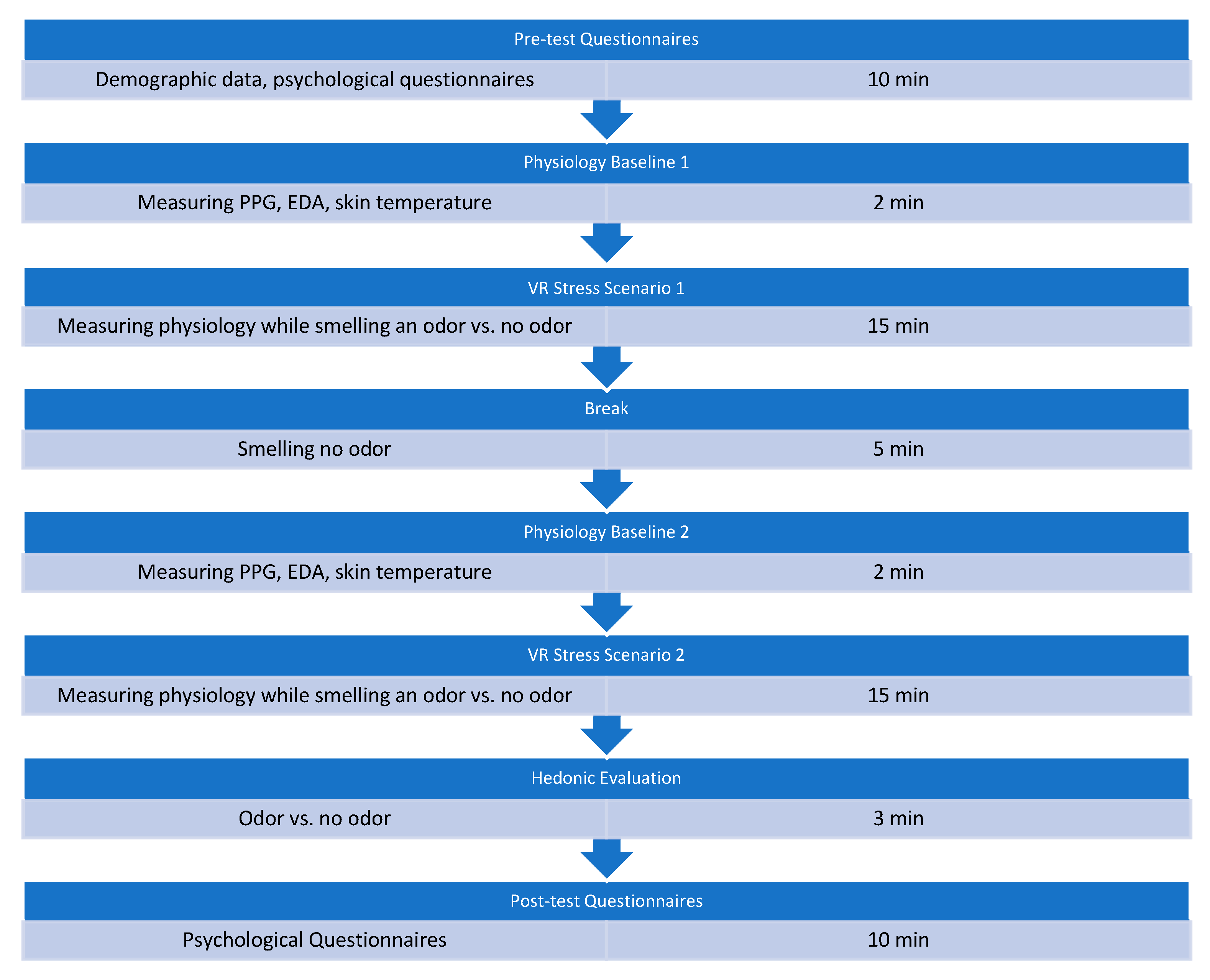
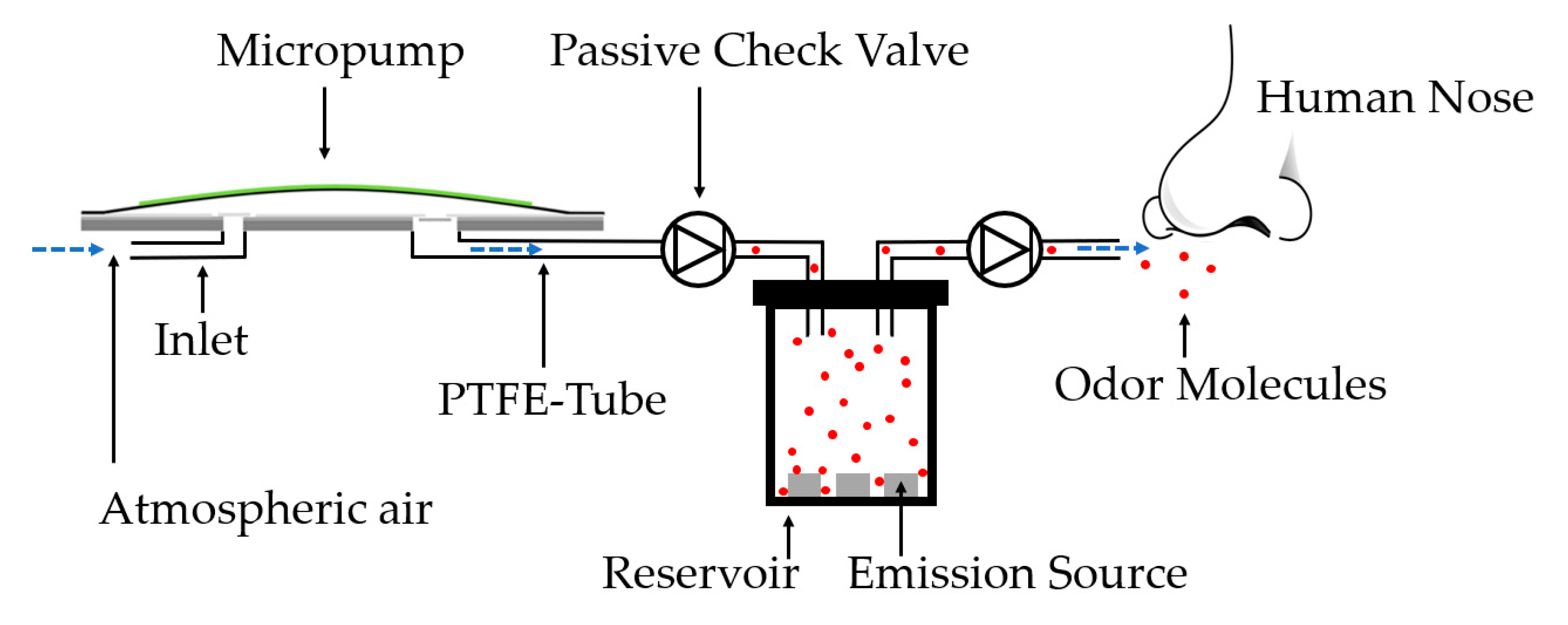

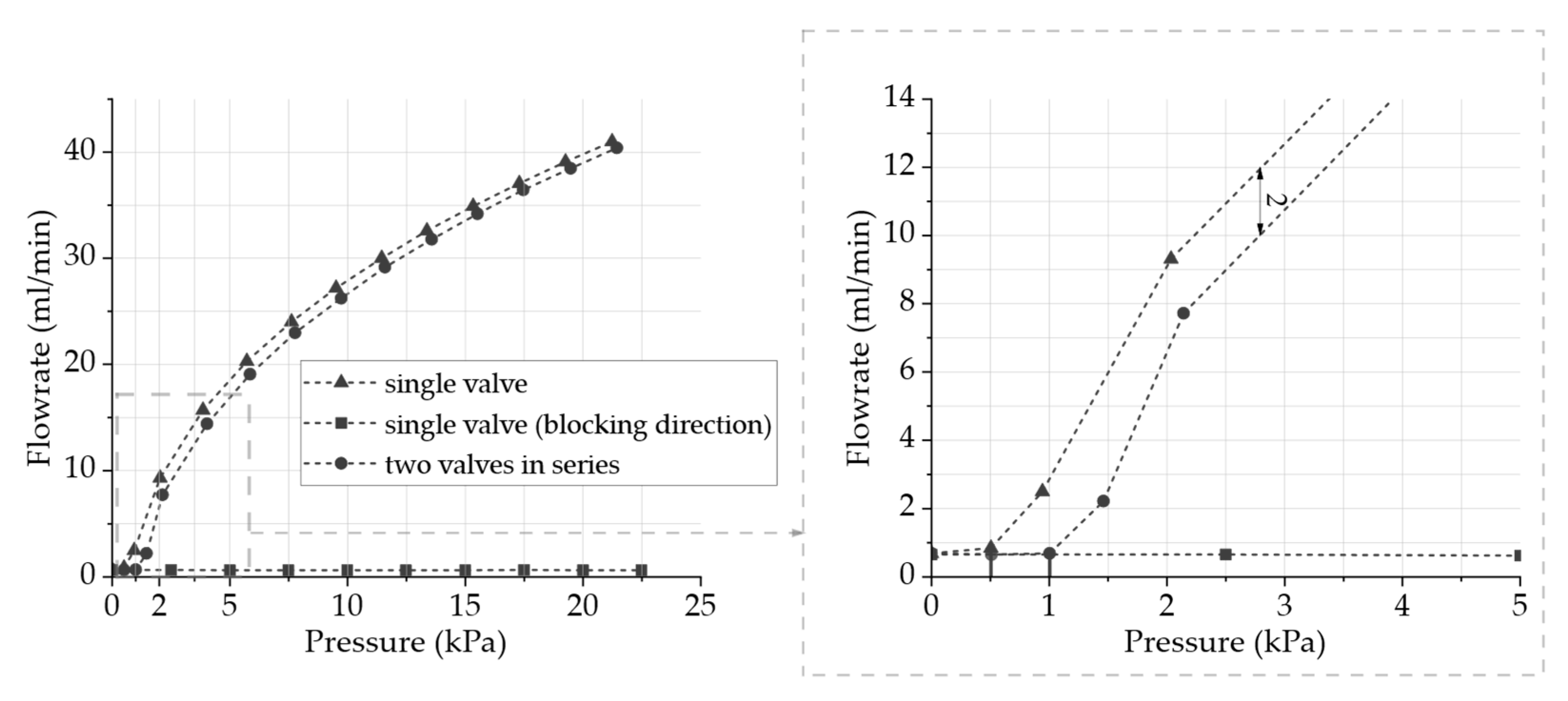
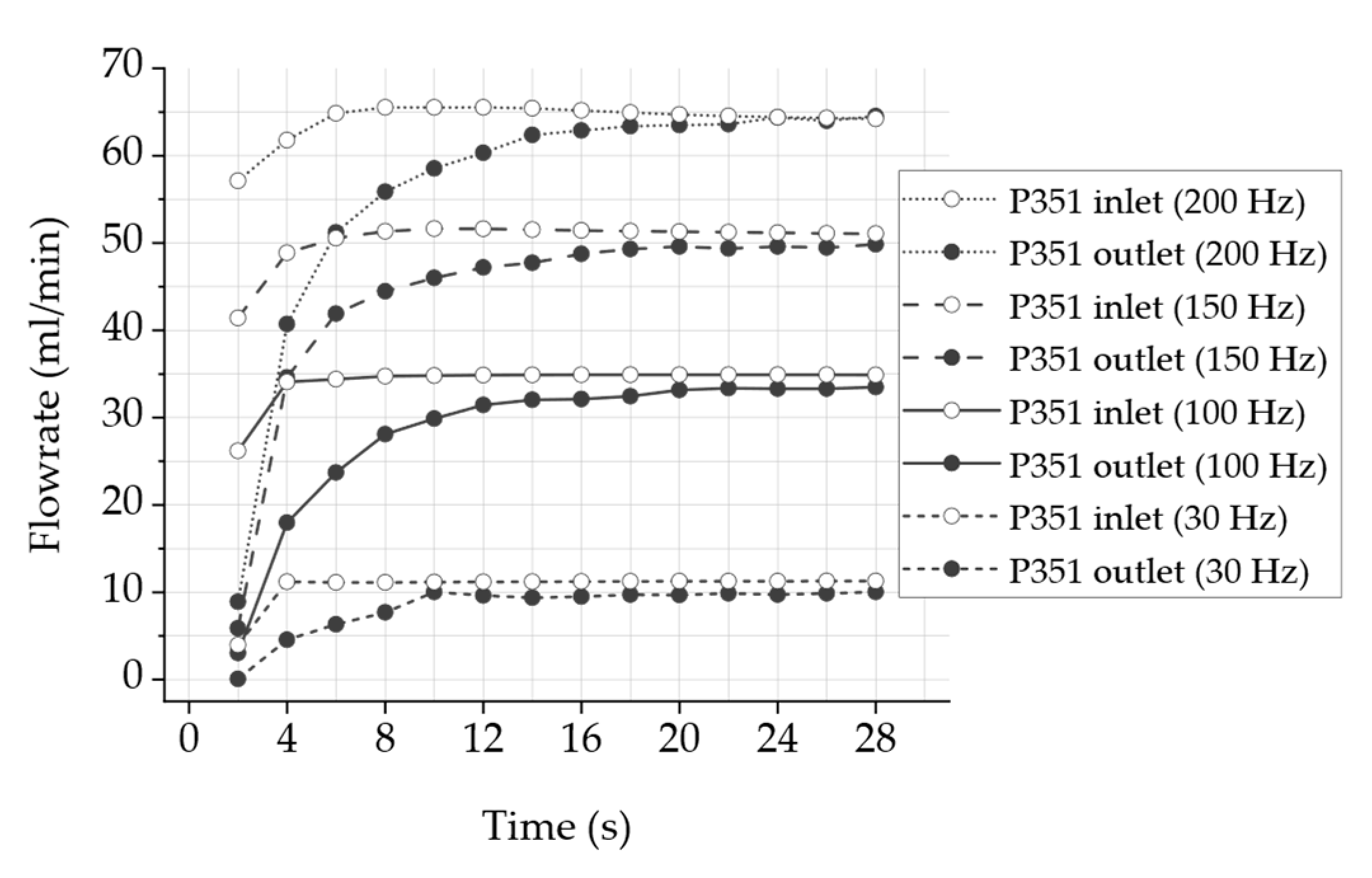
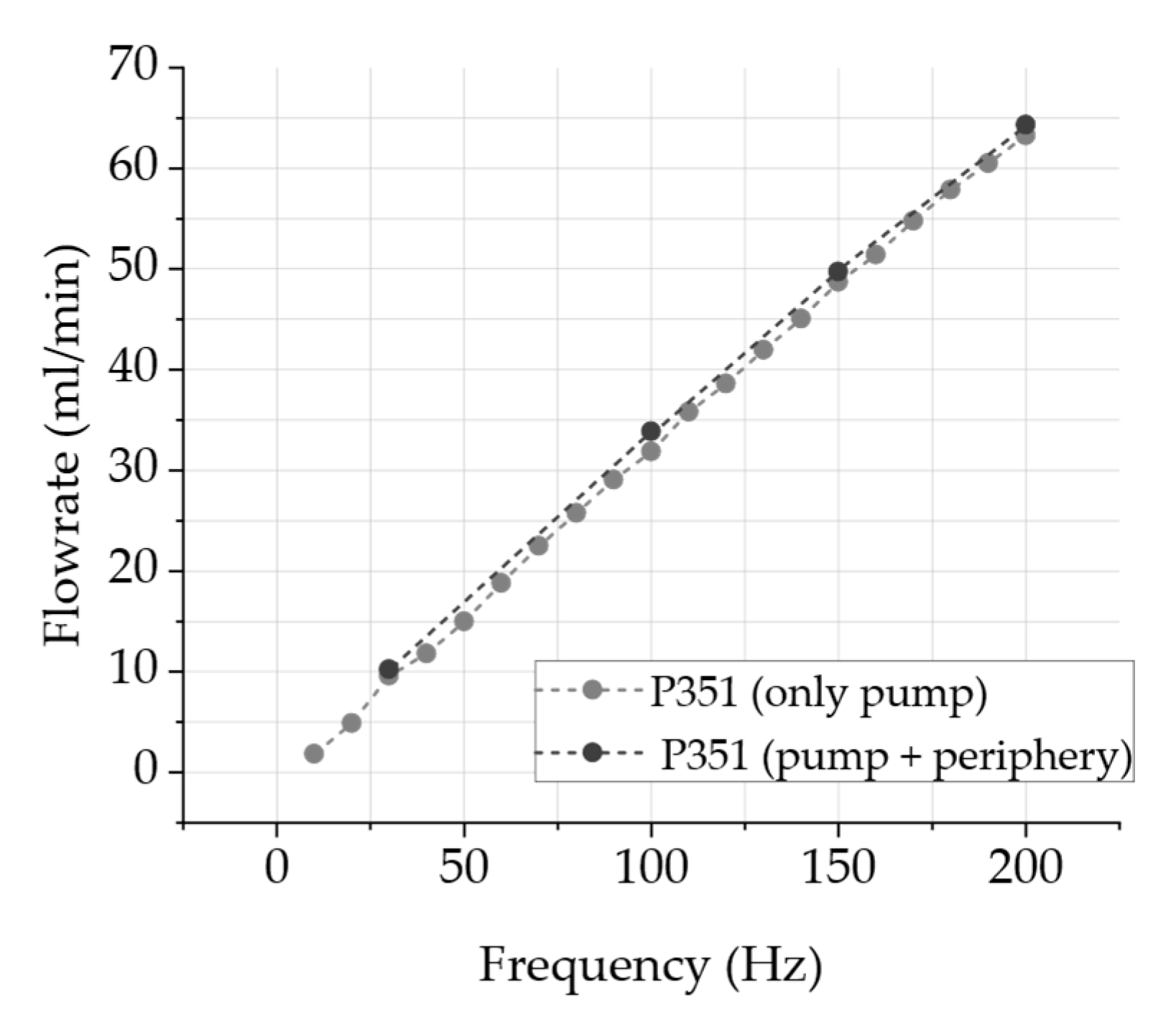


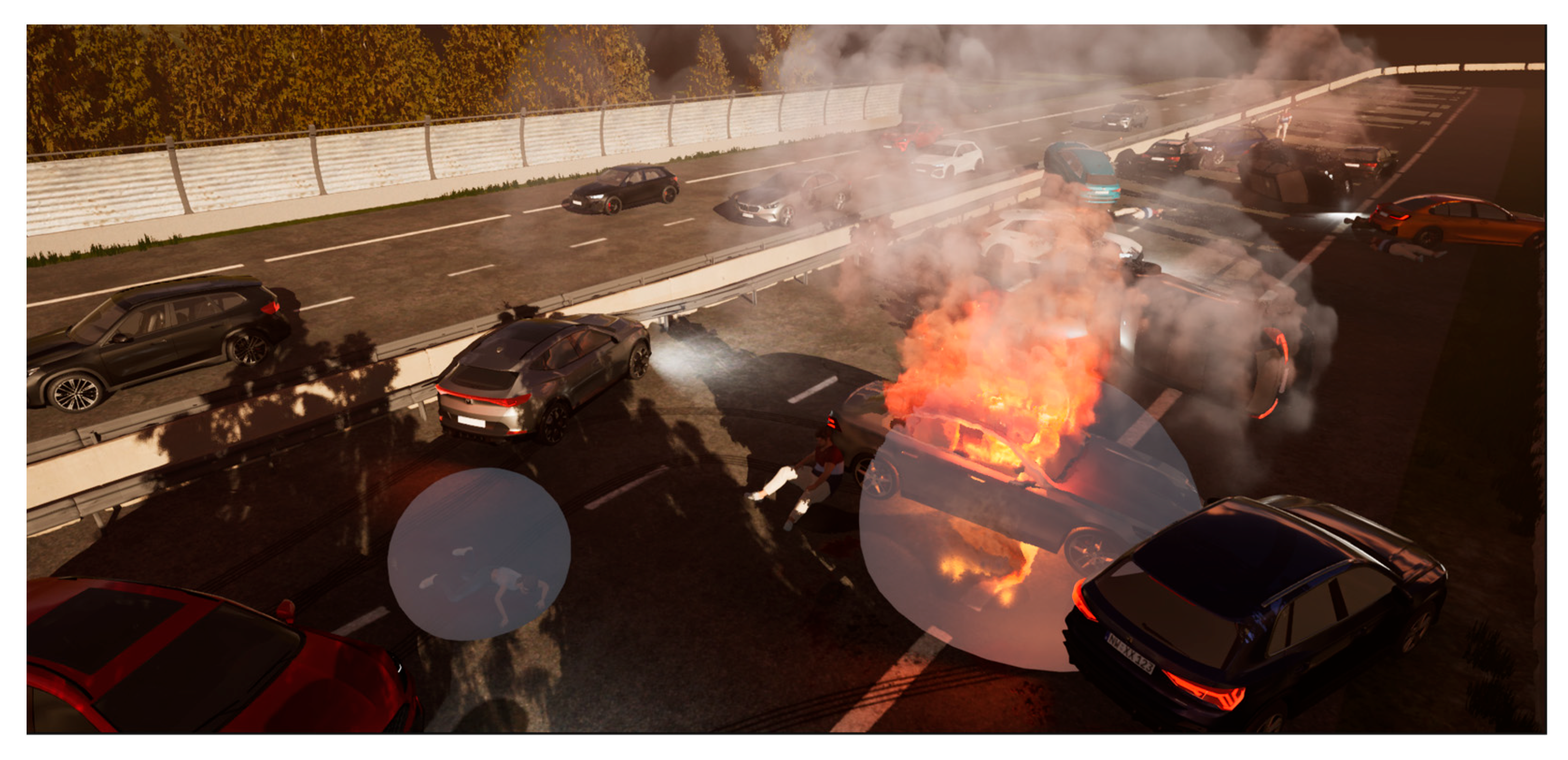
Disclaimer/Publisher’s Note: The statements, opinions and data contained in all publications are solely those of the individual author(s) and contributor(s) and not of MDPI and/or the editor(s). MDPI and/or the editor(s) disclaim responsibility for any injury to people or property resulting from any ideas, methods, instructions or products referred to in the content. |
© 2024 by the authors. Licensee MDPI, Basel, Switzerland. This article is an open access article distributed under the terms and conditions of the Creative Commons Attribution (CC BY) license (https://creativecommons.org/licenses/by/4.0/).
Share and Cite
Anheuer, D.; Karacan, B.; Herzog, L.; Weigel, N.; Meyer-Nieberg, S.; Gebhardt, T.; Freiherr, J.; Richter, M.; Leopold, A.; Eder, M.; et al. Framework for Microdosing Odors in Virtual Reality for Psychophysiological Stress Training. Sensors 2024, 24, 7046. https://doi.org/10.3390/s24217046
Anheuer D, Karacan B, Herzog L, Weigel N, Meyer-Nieberg S, Gebhardt T, Freiherr J, Richter M, Leopold A, Eder M, et al. Framework for Microdosing Odors in Virtual Reality for Psychophysiological Stress Training. Sensors. 2024; 24(21):7046. https://doi.org/10.3390/s24217046
Chicago/Turabian StyleAnheuer, Daniel, Brid Karacan, Lara Herzog, Nora Weigel, Silja Meyer-Nieberg, Thomas Gebhardt, Jessica Freiherr, Martin Richter, Armin Leopold, Monika Eder, and et al. 2024. "Framework for Microdosing Odors in Virtual Reality for Psychophysiological Stress Training" Sensors 24, no. 21: 7046. https://doi.org/10.3390/s24217046
APA StyleAnheuer, D., Karacan, B., Herzog, L., Weigel, N., Meyer-Nieberg, S., Gebhardt, T., Freiherr, J., Richter, M., Leopold, A., Eder, M., Hofmann, M., Renner, K. -H., & Küsel, C. (2024). Framework for Microdosing Odors in Virtual Reality for Psychophysiological Stress Training. Sensors, 24(21), 7046. https://doi.org/10.3390/s24217046




